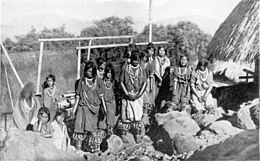TheKaren Hills,(S'gaw Karen:တီအူကစၢၢ်ခိၣ်,Burmese:ကရင်တောင်တန်း) also known asKayah-Karen Mountains,are one of the main hill ranges in easternBurma.They are located at the SW corner ofShan Stateand inKayah State,amountainousregion where the only relatively flat area isLoikaw,the capital. The southern end runs intoKayin State.One of the firstall-weather roadsin Burma was across the Karen Hills connectingTaungoowithLoilem.
| Karen Hills | |
|---|---|
 Location of the Karen Hills | |
| Highest point | |
| Peak | Nattaung[1] |
| Elevation | 2,623 m (8,606 ft) |
| Coordinates | 18°49′N97°2′E/ 18.817°N 97.033°E |
| Geography | |
 | |
| Country | Burma |
| Range coordinates | 19°12′N97°17′E/ 19.200°N 97.283°E |
| Parent range | Shan Hills |
| Geology | |
| Rock type(s) | Granite,limestone |


Lawpita Falls,Myanmar's largesthydropowerplant, built by theJapaneseaswar reparation,is located in these mountains.[2]
The name of the range is derived from theKaren peoplewho occupy the highland area. Incolonial timesthese mountains were often referred to as the "Toungoo Hills", for they rise east of Taungoo (formerly "Toungoo" ).[3]
Geography
editGeographically the Karen Hills are the southwestern projection of theShan Hills.[4] The highest peak isNattaung,[5]one of theultra prominent peaks in Southeast Asia.Another prominent mountain is 1,249 m highTakolaw Kyo.[6]
The Karen Hills rise from Burma's central plain and stretch for 120 km eastwards in their broadest part until they reach theSalween(Thanlwin) River valley. The steep gorge of this river, one of the main rivers in Burma, divides the Karen Hills from theDawna Rangein the east.[7]
Human activity and ecology
editThe Karen Hills are covered with dense montanerain forest.Local villages used to be far up in the hills and as much off the main roads as possible and villagers used to cultivateupland ricein forest clearings. Owing to the activity of theTatmadawin the area many local people have moved across the border intoThailandwhere they live inrefugee camps.[8]
These mountains are geologically and ecologically homogeneous with the neighboring Dawna Range and the head of theTenasserim Hills,so that frequently the wholemountainousarea is considered as a whole under the name "Kayah-Karen/Tenasserim".[9]They are covered withtropical and subtropical moist broadleaf forests,theKayah-Karen montane rain forests;these are part of theKayah-Karen/Tenasserim moist forestsecoregion[10]which is included in theGlobal 200list of ecoregions identified by theWorld Wildlife Fund (WWF)as priorities for conservation. Among the rare andvulnerable speciesin these highlands,Kitti's Hog-nosed Batand theholoparasiticflowering plantSapria himalayanadeserve mention.[11]
Protected areas
editThere were two main protected areas during British rule, theKahilu Reserved Forestand theSinswe Reserved Forest.Since the area is a conflict zone, theKNUinitially delimited an area in the Minanwe Wildlife Sanctuary, but in recent years these forests have seen unprecedented destruction.[12]
See also
editReferences
edit- ^Nattaung, Myanmar
- ^Lawpita Hydropower Project
- ^Sketches from the Karen Hills
- ^"Burma -Geography".Archived fromthe originalon 2012-02-07.Retrieved2011-12-13.
- ^Nattaung, Myanmar
- ^Takolaw Kyo, Burma
- ^Avijit Gupta,The Physical Geography of Southeast Asia,Oxford University Press, 2005.ISBN978-0-19-924802-5
- ^Karen Cultural Profile - Geography
- ^Global 200 ecoregion: Kayah-Karen / Tenasserim Moist Forests
- ^Kayah Karen Tenasserim EcoregionArchived2011-03-26 at theWayback Machine
- ^"Kayah-Karen montane rain forests".Terrestrial Ecoregions.World Wildlife Fund.
- ^Mu Traw district - Status of the Rainforest